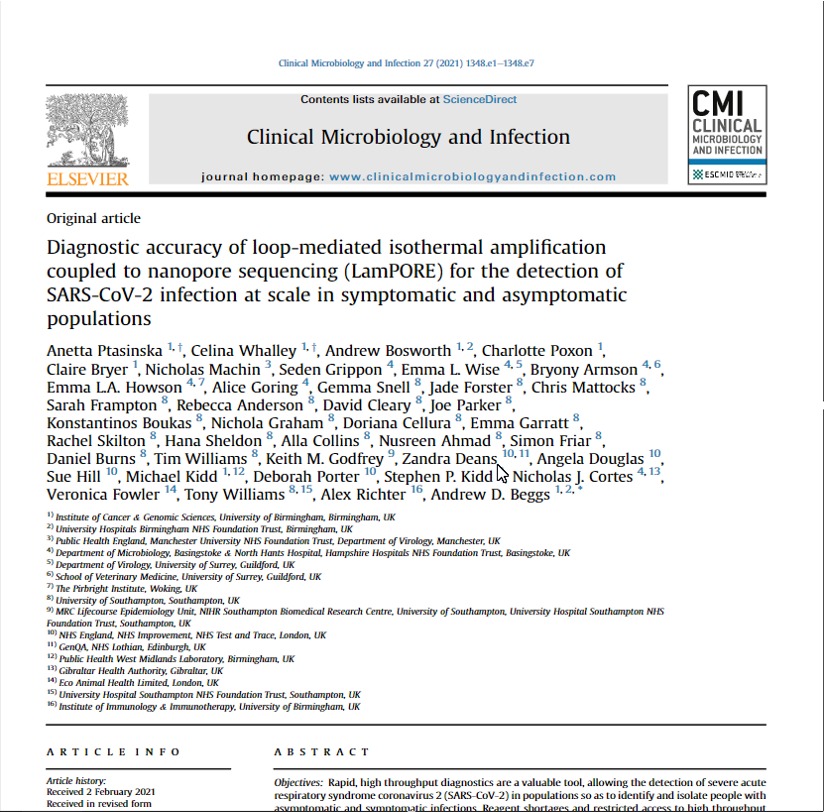
- September 22, 2021
Diagnostic accuracy of loop-mediated isothermal amplification coupled to nanopore sequencing (LamPORE) for the detection of SARS-CoV-2 infection at scale in symptomatic and asymptomatic populations.
Anetta Ptasinka, Celina Whalley, Andrew Bosworth, Charlotte Poxon, Claire Bryer, Nicholas Machin, Seden Grippon, Emma I. Wise, Bryony Armason, Emma L.A. Howson, Alice Goring, Gemma Snell, Jade Forster, Chris Mattocks, Sarah Frampton, Rebecca Anderson, David Cleary, Joe Parker, Konstantinos Boukas, Nichola Graham, Doriana Cellura, Emma Garratt, Rachel Skilton, Hana Sheldon, Alla Collins, Nusreen Ahmed, Simon Friar, Daniel Burns, Tim Williams, Keith M. Godfrey, Zandra Deans, Angela Douglas, Sue Hill, Michael Kidd, Deborah Porter, Stephen P. Kidd, Nicholas J. Cortes, Veronica Fowler, Tony Williams, Alex Richter, Andrew D. Beggs|Institute of Cancer & Genomic Sciences, University of Birmingham, Birmingham, UK, niversity Hospitals Birmingham NHS Foundation Trust, Birmingham, UK, Public Health England, Manchester University NHS Foundation Trust, Department of Virology, Manchester, UK, Department of Microbiology, Basingstoke & North Hants Hospital, Hampshire Hospitals NHS Foundation Trust, Basingstoke, UK, Department of Virology, University of Surrey, Guildford, UK, School of Veterinary Medicine, University of Surrey, Guildford, UK, The Pirbright Institute, Woking, UK, University of Southampton, Southampton, UK, MRC Lifecourse Epidemiology Unit, NIHR Southampton Biomedical Research Centre, University of Southampton, University Hospital Southampton NHS Foundation Trust, Southampton, UK, NHS England, NHS Improvement, NHS Test and Trace, London, UK, GenQA, NHS Lothian, Edinburgh, UK, Public Health West Midlands Laboratory, Birmingham, UK, Gibraltar Health Authority, Gibraltar, UK, Eco Animal Health Limited, London, UK, University Hospital Southampton NHS Foundation Trust, Southampton, UK, Institute of Immunology & Immunotherapy, University of Birmingham, UK|Clinical Microbiology and Infection|2021|1348.e1-1348.e7
COVID-19 caused by an emergent novel beta-coronavirus known as severe acute respiratory syndrome coronavirus 2 (SARS-CoV-2) has caused a world-wide public health emergency. The gold standard for the diagnostic detection of SARS-CoV-2 has been RT-qPCR. RT-qPCR can be laborious and difficult to scale up for mass testing. Loop-mediated isothermal amplification (LAMP) offers an alternative and can provide quicker run times of 20-30 minutes. In this study, they developed a test that has the combination of LAMP and nanopore sequencing developed by Oxford Nanopore Technologies, called LamPORE. 1200 health-care workers from five sites that are at high risk of asymptomatic transmission were recruited as part of the study where they performed self-swabs at days 0, 7, 14 and 21 as well as daily saliva sampling for 21 days. The samples were firstly extracted and then 20 ul was used for amplification and sequencing using the LamPORE method. A reference test was also carried out using the CerTest Viasure SARS-CoV-2 Real Time PCR Kit on the Mic qPCR Cycler using 5 ul of extracted RNA per reaction. Aligned read counts were generated via the LamPORE pipeline against ORF1ab, E1 and N2 genes, as well as a human ACTB gene internal control and reported results in absolute reads per sample per gene. Any unaligned reads were marked as undetermined. Samples were called positive if any of the target genes had >50 reads/sample, indeterminate if between 20 and 50 reads and negative if <20 reads. The LamPORE method was compared to the reference method using a 2×2 table and standard measures of sensitivity, specificity, positive predictive value and negative predictive value were calculated using R. It was found that LamPORE has high sensitivity and specificity (>99%) in both the asymptomatic and symptomatic populations, directly comparable to RT-qPCR.